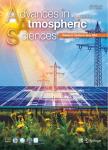Re-examination of Tropical Cyclone Formation in Monsoon Troughs over the Western North Pacific
Re-examination of Tropical Cyclone Formation in Monsoon Troughs over the Western North Pacific作者机构:Pacific Typhoon Research Center and Key Laboratory of Meteorological Disaster of Ministry of EducationNanjing University of Information Science and Technology State Key Laboratory of Severe WeatherChinese Academy of Meteorological Sciences
出 版 物:《Advances in Atmospheric Sciences》 (大气科学进展(英文版))
年 卷 期:2015年第32卷第7期
页 面:924-934页
核心收录:
学科分类:07[理学] 070601[理学-气象学] 0706[理学-大气科学]
基 金:supported by the National Basic Research Program of China (Grant Nos. 2013CB430103, 2015CB452803) the National Natural Science Foundation of China (Grant No. 41275093) the project of the "Specially-Appointed Professorship" of Jiangsu Province
主 题:monsoon trough tropical cyclone formation summer monsoon vertical wind shear
摘 要:The monsoon trough (MT) is one of the large-scale patterns favorable for tropical cyclone (TC) formation over the western North Pacific (WNP). This study re-examines TC formation by treating the MT as a large-scale background for TC activity during May-October. Over an 11-year (2000-10) period, 8.3 TC formation events on average per year are identified to occur within MTs, accounting for 43.1% of the total TC formation events in the WNP basin. This percentage is much lower than those reported in previous studies. Further analysis indicates that TC formation events in monsoon gyres were included at least in some previous studies. The MT includes a monsoon confluence zone where westerlies meet easterlies and a monsoon shear line where the trade easterlies lie north of the monsoon westerlies. In this study, the large-scale flow pattern associated with TC formation in the MT is composited based on the reference point in the confluence zone where both the zonal and meridional wind components are zero with positive vorticity. While previous studies have found that many TCs form in the confluence zone, the composite analysis indicates that nearly all of the TCs formed in the shear region, since the shear region is associated with stronger low-level relative vorticity than the confluence zone. The prevailing easterly vertical shear of zonal wind and barotropic instability may also be conducive to TC formation in the shear region, through the development of synoptic-scale tropical disturbances in the MT that are necessary for TC formation.



